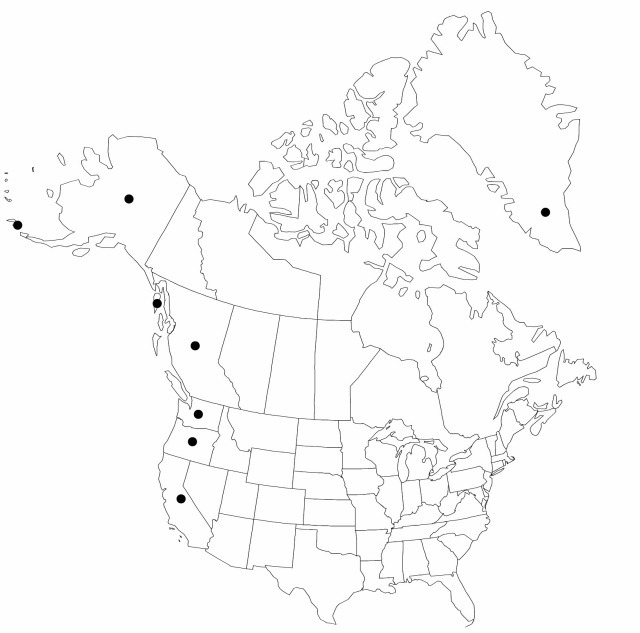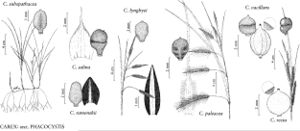Difference between revisions of "Carex lyngbyei"
in G. C. Oeder et al., Fl. Dan. 11(32): 6, plate 1888. 1827.
FNA>Volume Importer |
FNA>Volume Importer |
||
| Line 11: | Line 11: | ||
|name=Carex cryptocarpa | |name=Carex cryptocarpa | ||
|authority=C. A. Meyer | |authority=C. A. Meyer | ||
| + | |rank=species | ||
}} {{Treatment/ID/Synonym | }} {{Treatment/ID/Synonym | ||
|name=Carex lyngbyei var. cryptocarpa | |name=Carex lyngbyei var. cryptocarpa | ||
|authority=(C. A. Meyer) Hultén | |authority=(C. A. Meyer) Hultén | ||
| + | |rank=variety | ||
}} {{Treatment/ID/Synonym | }} {{Treatment/ID/Synonym | ||
|name=Carex lyngbyei var. robusta | |name=Carex lyngbyei var. robusta | ||
|authority=(L. H. Bailey) Cronquist | |authority=(L. H. Bailey) Cronquist | ||
| + | |rank=variety | ||
}} {{Treatment/ID/Synonym | }} {{Treatment/ID/Synonym | ||
|name=Carex salina var. robusta | |name=Carex salina var. robusta | ||
|authority=L. H. Bailey | |authority=L. H. Bailey | ||
| + | |rank=variety | ||
}} | }} | ||
|hierarchy=Cyperaceae;Carex;Carex sect. Phacocystis;Carex lyngbyei | |hierarchy=Cyperaceae;Carex;Carex sect. Phacocystis;Carex lyngbyei | ||
| Line 45: | Line 49: | ||
-->{{#Taxon: | -->{{#Taxon: | ||
name=Carex lyngbyei | name=Carex lyngbyei | ||
| − | |||
|authority=Hornemann in G. C. Oeder et al. | |authority=Hornemann in G. C. Oeder et al. | ||
|rank=species | |rank=species | ||
| Line 60: | Line 63: | ||
|publication year=1827 | |publication year=1827 | ||
|special status= | |special status= | ||
| − | |source xml=https://jpend@bitbucket.org/aafc-mbb/fna-data-curation.git/src/ | + | |source xml=https://jpend@bitbucket.org/aafc-mbb/fna-data-curation.git/src/f50eec43f223ca0e34566be0b046453a0960e173/coarse_grained_fna_xml/V23/V23_677.xml |
|genus=Carex | |genus=Carex | ||
|section=Carex sect. Phacocystis | |section=Carex sect. Phacocystis | ||
Revision as of 20:10, 16 December 2019
Plants not cespitose. Culms obtusely or acutely angled, 25–130 cm, glabrous. Leaves: basal sheaths red-brown; sheaths of proximal leaves glabrous, fronts lacking spots and veins, apex U-shaped; blades hypostomic, 3–8 mm wide, abaxially papillose. Proximal bract longer than inflorescence, 3–6 mm wide. Spikes usually pendent; staminate 2–3; pistillate 2–4; proximal pistillate spike 1.8–5 cm × 5–7 mm, base obtuse. Pistillate scales red-brown to dark purple-brown, longer than perigynia, apex acuminate, awnless. Perigynia divergent, yellow-brown with pale brown spots on apical 1/2, 5–7-veined on each face, somewhat inflated, loosely enclosing achenes, 2.5–3.5 × 1.6–2.5 mm, leathery, dull, base with stipe to 0.5 mm, apex obtuse or rounded, papillose; beak thickened, 0.1–0.3 mm. Achenes constricted on 1 or both margins, apex rounded; style base straight. 2n = 68, 70, 72.
Phenology: Fruiting Jul–Aug.
Habitat: Coastal salt marshes, brackish marshes
Elevation: 0–10 m
Distribution

Greenland, B.C., Alaska, Calif., Oreg., Wash., Europe (Iceland).
Discussion
Carex lyngbyei is the common sedge of the Pacific coastal salt marshes. It may easily be distinguished from sympatric species by the large, pendent, pedunculate spikes and the leathery, yellow-brown perigynia.
Although the species is also reported to occur in Japan and Korea, some Asian collections show significant morphologic and habitat differences from the North American plants. It is probably most closely related to Carex paleacea and to the South American C. darwinii, and differs from C. paleacea primarily by having acute, rather than awned, scales. Previous reports from eastern North American were misidentifications (J. Cayouette 1987).
Selected References
None.
